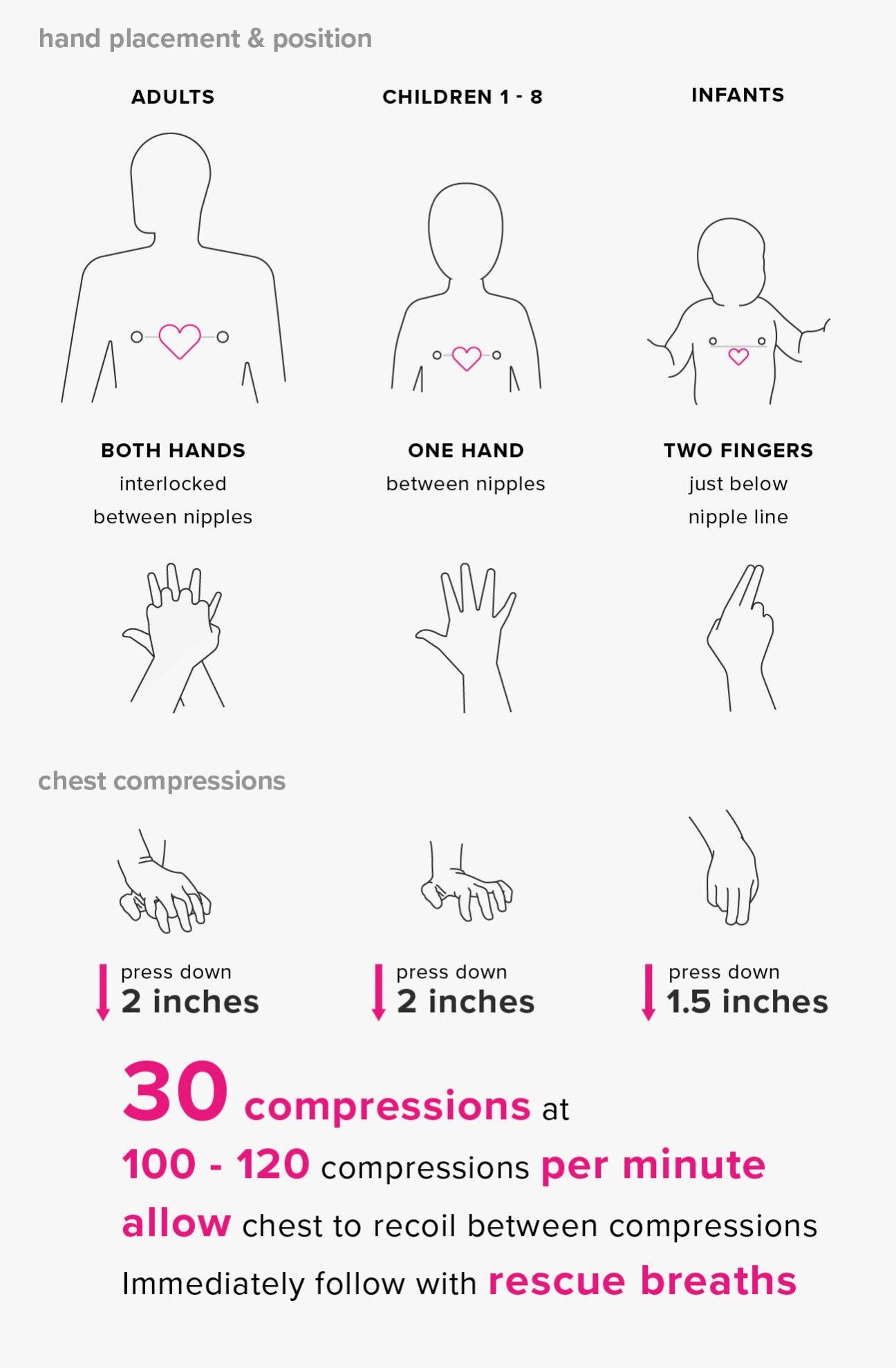Chest compressions are a crucial part of performing CPR on a child in the event of cardiac arrest. It is essential to understand the proper techniques and guidelines for administering chest compressions and minimizing interruptions to ensure the best possible outcome.
Firstly, it is necessary to position yourself correctly when performing chest compressions on a child. You should position your shoulders directly over your hands and lock your elbows while keeping your arms straight. This position will allow you to use your body weight to apply adequate pressure during compressions.
When compressing the chest of a child, aim for a depth of about 2 inches. Each compression should be fast and hard with no pausing. For infants, compress to a depth of 1 ½ inches. It is essential to allow the chest to return to its normal position after each compression.
The American Heart Association recommends a rate of 100 to 120 chest compressions per minute. It is crucial to maintain this rate consistently throuhout the CPR process to ensure the most effective results. When giving 30 chest compressions, allow the child’s chest to rise completely before beginning the next set.
One of the most critical factors in successful CPR is minimizing interruptions to chest compressions. Interruptions can decrease the effectiveness of compressions and reduce the chances of a positive outcome. The American Heart Association recommends limiting interruptions to under 10 seconds.
It is important to note that when performing CPR on a child, chest compressions should always be accompanied by ventilation. However, excessive ventilation should be avoided. The ratio of compressions to ventilations should be 30:2 for infants and children.
Performing chest compressions during CPR on a child is a critical aspect of the process. It is important to position yourself correctly, aim for the appropriate depth and rate, and minimize interruptions to the best of your ability. By following these guidelines, you can increase the chances of a positive outcome and potentially save a child’s life.
Limiting Interruptions During Chest Compressions on a Child
When performing chest compressions on infants and children who remain pulseless despite initial interventions, it is crucial to minimize interruptions as much as possible. The recommended time limit for interruptions during chest compressions is less than or equal to 10 seconds. This means that when providing rescue breaths or any oher interventions during CPR, the pause in chest compressions should be brief, ideally lasting no more than 10 seconds. This is because interruptions in chest compressions can significantly reduce the effectiveness of circulation, which is vital for providing oxygenated blood to the brain and vital organs. Therefore, it is essential to prioritize the continuous delivery of high-quality chest compressions while minimizing interruptions to improve the chances of a successful resuscitation.

Source: cnn.com
Depth of Compressions When Performing CPR on a Child
When performing CPR on a child, it is important to compress their chest to a depth of about 2 inches. This means that you sould press down on the chest firmly enough to cause the chest to move downwards by approximately 2 inches. It is important to note that this depth is different than that of an adult, which should be at least 2 inches, and an infant, which should be 1 ½ inches. By compressing the chest to the correct depth, you can help to ensure that the blood is being circulated properly throughout the body, which is critical for the success of the CPR procedure.
Performing Chest Compressions on a Child
When performing chest compressions on a child, it is important to follow the proper technique to ensure the best chance of success. First, position yourself so that your shoulders are directly over your hands and lock your elbows. This will give you the leverage you need to push down with enough force. Next, keep your arms straight as you push down hard and fast about 2 inches, aiming for a rate of 100 to 120 compressions per minute. It is crucial to maintain this pace and depth to ensure that you are effectively circulating blood to the child’s vital organs. After each compression, alow the chest to return to its normal position before beginning the next one. By following these steps, you can provide the child with the best chance of survival in an emergency situation.
Proper Depth for CPR Compressions on an 8 Year Old Child
When providing CPR compressions on an 8 year old child, the proper depth for compressions is aout 1/3 to 1/2 the depth of the chest. This means that you should press down on the child’s chest with enough force to compress it by approximately 2-2.4 inches. The compressions should be fast and hard, with no pausing, and you should aim to give 30 compressions in a row before moving on to the next step of CPR. It is important to let the chest rise completely between compressions to allow for proper blood flow and oxygenation. By following these guidelines, you can help increase the chances of survival for a child experiencing cardiac arrest.
Chest Compression Speed for Children Ages 1 to 8
For children between the ages of 1 and 8, the recommended rate for chest compressions during CPR is 100-120 compressions per minute. It is important to maintain a consistent and steady rhythm while compressing the chest, with each compression being about one-third the depth of the chest. It is also recommended to use the heel of one hand for compressions on children over the age of one, and to use two hands for compressions on larger children. Remember that in any CPR situation, it is important to call for emergency medical services as soon as possible.

Source: verywellhealth.com
The 30-2 Rule in CPR
The 30 2 rule in CPR refers to the recommended ratio of chest compressions to rescue breaths during CPR. This guideline suggests that after every 30 chest compressions, two rescue breaths should be administered. This ratio is based on the principle that chest compressions help to circulate blood throughout the body, while rescue breaths deliver oxygen to the lungs. The goal of CPR is to keep the person’s blood flowing until medical personnel can take over. If two people are performing CPR, the ratio changes to one to two breaths after every 15 chest compressions. It is important to continue CPR until you see signs of life or until medical personnel arrive. Following the 30 2 rule can help improve the chances of survival for someone experiencing cardiac arrest.
Depth of Compressions for CPR on a Child
When performing CPR on a child, the correct depth of chest compressions is at last 1/3 depth of the chest, or about 2 inches. This means that you need to push down hard enough to compress the chest and create blood flow to the heart and brain. It is important to use the proper hand placement and technique to ensure effective compressions. Remember to also maintain a compression-to-ventilation ratio of 30:2 and to continue performing compressions until professional medical help arrives. Proper CPR can greatly increase a child’s chances of survival, so it is important to be knowledgeable and prepared in case of an emergency.
Performing Chest Compressions on a Child
Performing chest compressions on a child can be a life-saving technique in case of cardiac arrest. Here is a step by step guide on how to do chest compressions on a child.
1. Place the child on a firm and flat surface, such as the ground or a table. If possible, ask someone to call 911 or emergency services immediately.
2. Kneel beside the child and place the heel of one hand on the breastbone, which is located just below the nipples.
3. Keep your othr hand on the child’s forehead and gently tilt the head back to open the airway.
4. Press down on the child’s chest with the heel of your hand, using enough force to compress about one-third to one-half of the depth of the chest.
5. Give 30 chest compressions at a rate of 100-120 per minute. Count out loud while performing the compressions.
6. After 30 compressions, give two breaths by placing your mouth over the child’s mouth and nose and blowing air into the lungs.
7. Continue with cycles of 30 compressions and two breaths until emergency help arrives or the child starts breathing on their own.
It is important to remember that chest compressions should be performed with proper technique, as too little or too much force can cause injury to the child’s chest. It is recommended to take a CPR class to learn and practice this life-saving technique.
Remembering the Most Important Thing When Performing CPR on a Child
The most important thing to remember when performing CPR on a child is to adjust the technique according to the child’s size and age. As children have smaller and more delicate bodies than adults, it is crucial to use a 30:2 compressions to breaths ratio if performing CPR alone, or a 15:2 ratio if there are two rescuing individuals. Additionally, it is essential to compress the chest to a depth of 1/3 of the chest’s depth, wich is approximately 1.5 inches or less for younger children. By adjusting the technique to the child’s size and age, you can ensure that the CPR is performed correctly and effectively, increasing the child’s chances of survival.

Source: healthline.com
Child CPR: Number of Compressions
Child CPR involves performing 30 chest compressions follwed by 2 rescue breaths. This ratio is the same for both infants and children. The recommended depth of compressions for a child is at least one-third of the depth of the chest, or approximately 2 inches. It is important to note that the rate of compressions should be at least 100 per minute, and the child should be placed on a firm surface with their head tilted back slightly to open up the airway. CPR should only be performed by individuals who have been trained in proper techniques and procedures. Prompt and effective CPR can greatly increase the chances of survival in a child experiencing cardiac arrest.
Giving Chest Compressions to a Child
When giving chest compressions to a child, it is important to first make sure the child is lying on their back on a firm, flat surface. Next, move any clothing out of the way so that you have access to their chest. Then, place two fingers of one hand on the breastbone just below the nipple line. You will need to press the child’s chest straight down about 1 1/2 inches at a rate of at last 100 compressions per minute. It is important to maintain this rate and depth until medical help arrives or until the child begins to breathe on their own. Remember to always call for emergency medical help as soon as possible.
Providing CPR on a Child or Infant: First Steps
When proviing CPR on a child or infant, the first step is to check for responsiveness. This means that you should gently tap or shake the child while calling out their name or saying “Are you okay?” If the child is unresponsive, then you need to immediately call for emergency medical services. After calling for help, you should begin performing CPR by giving 30 chest compressions followed by opening the airway and checking for breathing. If the child is not breathing, then you should give 2 rescue breaths and continue giving CPR (30 chest compressions, 2 breaths, repeat) until help arrives. Remember, the most important thing is to act quickly and confidently in order to give the child the best chance of survival.
Measures of High Quality Chest Compressions for a Child
When it comes to performing high-quality chest compressions on a child, there are three important measures that need to be followed. Firstly, the compression rate should be between 100-120 compressions per minute. Secondly, the compression depth should be at least 1/3 the AP dimension of the chest. And lastly, the chest compression fraction should be greater than 80%. This means that the rescuer should aim to minimize interruptions in chest compressions and avoid excessive ventilation. By following these three measures, the rescuer can ensure that the child is receiving effective and life-saving chest compressions.

Source: cprcertificationhouston.org
Conclusion
Chest compressions are a vital component of cardiopulmonary resuscitation (CPR) and can help save the life of someone experiencing cardiac arrest. It is important to perform them correctly, with the appropriate depth and rate of compression, and to ensure minimal interruptions to maintain blood flow to the vital organs. For adults, compress the chest to a depth of at least 2 inches, for children compress to a depth of abot 2 inches, and for infants compress to a depth of 1 ½ inches. Remember to position your shoulders directly over your hands and lock your elbows, keeping your arms straight. Give 30 chest compressions at a fast and hard pace, allowing the chest to rise completely after each compression. By following these guidelines, you can help improve the chances of a successful resuscitation and save a life.
